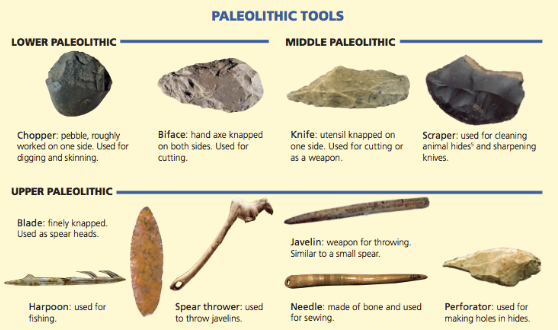- Gyankosh
- Current Affairs
- Value Addition
- PYQS
- Contact Page
- About Us
Palaeolithic Age
Palaeolithic Age (Hunters and Food Gatherers)
Earliest period of the Stone Age, developed during the Pleistocene period or Ice Age.
Geographical spread: Found across India, except the alluvial plains of the Indus and Ganga.
Palaeolithic people in India belonged to the Negrito race, lived in caves and rock shelters.
Lifestyle:
- Hunters and food gatherers, dependent on hunting and gathering wild fruits and vegetables.
- No knowledge of agriculture, house building, pottery, or metals.
- Knowledge of fire came only in later stages.
Tools: Made from unpolished, rough stones, primarily:
- Hand axes, cleavers, choppers, blades, burins, and scrapers.
- Tools made from hard rock called ‘quartzite’, hence also referred to as ‘Quartzite men’ in India.
Divisions of Palaeolithic Age based on tools used:
- Lower Palaeolithic: Oldest tools like hand axes and cleavers.
- Middle Palaeolithic: Tools with finer flaking, like flakes and scrapers.
- Upper Palaeolithic: Advanced tools like blades and burins.

| Phase | Tools | Regions Found | Time Period | Specialties |
| Early or Lower Palaeolithic | Hand axes, cleavers, choppers, primarily used for basic tasks like chopping, digging, and skinning. | Found in Soan and Sohan river valleys (now in Pakistan), Kashmir, Thar Desert, Didwana (Rajasthan), Hiran Valley (Gujarat), Bhimbetka (MP), and Belan Valley (UP). | 5,00,000 BCE – 50,000 BCE | Represents the greater part of the Ice Age, showing early human activity. |
| Middle Palaeolithic | Tools made from flakes, including scrapers, borers, points, and bladelike tools. | Found in Soan, Narmada, Tungabhadra river valleys, Potwar Plateau (between Indus and Jhelum), Sanghao Cave (near Peshawar, Pakistan). | 50,000 BCE – 40,000 BCE | Nevasan industry was established in 1960 by H.D. Sankalia, named after the site of Nevasa (Maharashtra). |
| Late or Upper Palaeolithic | Parallel-sided blades, burins, and some instances of bone tools. | Found in Andhra Pradesh, Karnataka, Maharashtra, Central MP, Southern UP, and Chhotanagpur Plateau. Bone tools found at cave sites of Kurnool and Muchchatla Chintamani Gavi in Andhra Pradesh. | 40,000 BCE – 10,000 BCE | Homo sapiens first appeared at the end of this phase, coinciding with the last phase of the Ice Age, when the climate became warmer and less humid. |


